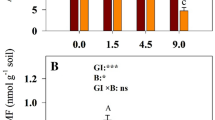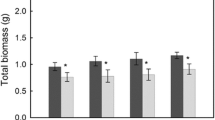Abstract
Aims
We quantified the potential influence of arbuscular mycorrhizal fungi (AMF) on primary productivity and community stability and tested whether the effects of AMF depend on soil phosphorus (P) availability and grazing intensity in a semiarid grassland.
Methods
We manipulated the abundance of AMF and soil P availability (P addition and no P addition) under four levels of grazing intensity. The aboveground biomass of plant species, functional groups and community, as well as community temporal stability were examined under these conditions.
Results
Under no to moderate grazing, benomyl decreased the aboveground biomass in C4 grasses and forbs, but increased the aboveground biomass in C3 grasses under low P conditions; thus no obvious changes in community primary productivity were observed. These results indicated that the mycorrhizal dependency of C4 grasses and forbs is higher than that of C3 grasses under low P conditions. However, community primary productivity was greatly enhanced by benomyl due to the increased biomasses of C3 grasses and forbs under high P conditions. Under heavy grazing conditions, benomyl increased community primary productivity under both low and high P conditions. AMF presence increased the community temporal stability by promoting the compensatory effects between plant species under no to moderate grazing conditions; whereas AMF decreased the community stability by forming a parasitic symbiosis with their plant hosts under heavy grazing conditions.
Conclusions
Our findings demonstrate that the effects of benomyl application to suppress AMF on primary productivity and community stability are strongly mediated by soil P availability and grazing intensity, which improves our understanding for the roles of AMF-plant symbiosis on ecosystem functioning in grazed systems.





Similar content being viewed by others
References
Ba L, Ning JX, Wang DL, Facelli E, Facelli JM, Yang YN, Zhang LC (2012) The relationship between the diversity of arbuscular mycorrhizal fungi and grazing in a meadow steppe. Plant Soil 352:143–156
Bai YF, Han XG, Wu JG, Chen ZZ, Li LH (2004) Ecosystem stability and compensatory effects in the Inner Mongolia grassland. Nature 431:181–184. https://doi.org/10.1038/nature02850
Bai YF, Wu JG, Clark CM, Naeem S, Pan QM, Huang JH, Zhang LX, Han XG (2010) Tradeoffs and thresholds in the effects of nitrogen addition on biodiversity and ecosystem functioning: evidence from inner Mongolia grasslands. Glob Chang Biol 16:358–372
Bao YY, Yan W (2004) Arbuscular mycorrhizae and their structural types on common plants in grasslands of mid-western Inner Mongolia. Biodivers Sci 12:501–508
Barto EK, Rillig MC (2010) Does herbivory really suppress mycorrhiza? A meta-analysis. J Ecol 98:745–753. https://doi.org/10.1111/j.1365-2745.2010.01658.x
Bates D, Machler M, Bolker BM, Walker SC (2015) Fitting linear mixed-effects models using lme4. J Stat Softw 67:1–48. https://doi.org/10.18637/jss.v067.i01
Bender SF, van der Heijden MGA (2015) Soil biota enhance agricultural sustainability by improving crop yield, nutrient uptake and reducing nitrogen leaching losses. J Appl Ecol 52:228–239. https://doi.org/10.1111/1365-2664.12351
Bossio DA, Scow KM, Gunapala N, Graham KJ (1998) Determinants of soil microbial communities: effects of agricultural management, season, and soil type on phospholipid fatty acid profiles. Microb Ecol 36:1–12
Brundrett MC, Tedersoo L (2018) Evolutionary history of mycorrhizal symbioses and global host plant diversity. New Phytol 220:1108–1115. https://doi.org/10.1111/nph.14976
Collins CD, Foster BL (2009) Community-level consequences of mycorrhizae depend on phosphorus availability. Ecology 90:2567–2576. https://doi.org/10.1890/08-1560.1
Frostegård Å, Tunlid A, Bååth E (2011) Use and misuse of PLFA measurements in soils. Soil Biol Biochem 43:1621–1625. https://doi.org/10.1016/j.soilbio.2010.11.021
Gehring CA, Whitham TG (2002) Mycorrhizae-herbivore interactions: population and community consequences. In: van der Heijden M, Sanders I (eds) Mycorrhizal ecology, ecological studies. Springer, Heidelberg, Germany, pp 295–320
Grman E (2012) Plant species differ in their ability to reduce allocation to non-beneficial arbuscular mycorrhizal fungi. Ecology 93:711–718. https://doi.org/10.1890/11-1358.1
Grman E, Robinson TMP (2013) Resource availability and imbalance affect plant-mycorrhizal interactions: a field test of three hypotheses. Ecology 94:62–71. https://doi.org/10.1890/12-0385.1
Hartnett DC, Wilson GWT (1999) Mycorrhizae influence plant community structure and diversity in tallgrass prairie. Ecology 80:1187–1195. https://doi.org/10.1890/0012-9658(1999)080[1187:mipcsa]2.0.co;2
Hartnett DC, Wilson GWT (2002) The role of mycorrhizas in plant community structure and dynamics: lessons from grasslands. Plant Soil 244:319–331. https://doi.org/10.1023/a:1020287726382
Hautier Y, Seabloom EW, Borer ET, Adler PB, Harpole WS, Hillebrand H, Lind EM, MacDougall AS, Stevens CJ, Bakker JD, Buckley YM, Chu CJ, Collins SL, Daleo P, Damschen EI, Davies KF, Fay PA, Firn J, Gruner DS, Jin VL, Klein JA, Knops JMH, La Pierre KJ, Li W, McCulley RL, Melbourne BA, Moore JL, O'Halloran LR, Prober SM, Risch AC, Sankaran M, Schuetz M, Hector A (2014) Eutrophication weakens stabilizing effects of diversity in natural grasslands. Nature 508:521–525. https://doi.org/10.1038/nature13014
Hector A, Hautier Y, Saner P, Wacker L, Bagchi R, Joshi J, Scherer-Lorenzen M, Spehn EM, Bazeley-White E, Weilenmann M, Caldeira MC, Dimitrakopoulos PG, Finn JA, Huss-Danell K, Jumpponen A, Mulder CPH, Palmborg C, Pereira JS, Siamantziouras ASD, Terry AC, Troumbis AY, Schmid B, Loreau M (2010) General stabilizing effects of plant diversity on grassland productivity through population asynchrony and overyielding. Ecology 91:2213–2220. https://doi.org/10.1890/09-1162.1
Hodge A, Fitter AH (2013) Microbial mediation of plant competition and community structure. Funct Ecol 27:865–875. https://doi.org/10.1111/1365-2435.12002
Hoeksema JD, Chaudhary VB, Gehring CA, Johnson NC, Karst J, Koide RT, Pringle A, Zabinski C, Bever JD, Moore JC, Wilson GWT, Klironomos JN, Umbanhowar J (2010) A meta-analysis of context-dependency in plant response to inoculation with mycorrhizal fungi. Ecol Lett 13:394–407. https://doi.org/10.1111/j.1461-0248.2009.01430.x
ISSS Working Group RB (1998) World Reference Base for soil resources. Atlas (E.M. Bridges, N.H.Batjes, F.O. Nachtergaele Eds). First edition. ISSS/ISRIC/FAO, Acco Leuven
Jin L, Wang Q, Wang Q, Wang XJ, Gange AC (2017) Mycorrhizal-induced growth depression in plants. Symbiosis 72:81–88. https://doi.org/10.1007/s13199-016-0444-5
Johnson NC (2010) Resource stoichiometry elucidates the structure and function of arbuscular mycorrhizas across scales. New Phytol 185:631–647. https://doi.org/10.1111/j.1469-8137.2009.03110.x
Johnson NC, Graham JH, Smith FA (1997) Functioning of mycorrhizal associations along the mutualism-parasitism continuum. New Phytol 135:575–586. https://doi.org/10.1046/j.1469-8137.1997.00729.x
Loreau M, de Mazancourt C (2013) Biodiversity and ecosystem stability: a synthesis of underlying mechanisms. Ecol Lett 16:106–115. https://doi.org/10.1111/ele.12073
McGonigle TP (1988) A numerical analysis of published field trials with vesicular-arbuscular mycorrhizal fungi. Funct Ecol 2:473–478. https://doi.org/10.2307/2389390
Murray TR, Frank DA, Gehring CA (2010) Ungulate and topographic control of arbuscular mycorrhizal fungal spore community composition in a temperate grassland. Ecology 91:815–827. https://doi.org/10.1890/09-0209.1
Naeem S, Li SB (1997) Biodiversity enhances ecosystem reliability. Nature 390:507–509. https://doi.org/10.1038/37348
O'Connor PJ, Smith SE, Smith FA (2002) Arbuscular mycorrhizas influence plant diversity and community structure in a semiarid herbland. New Phytol 154:209–218. https://doi.org/10.1046/j.1469-8137.2002.00364.x
Olsen SR, Cole CV, Watanabe FS, Dean LA (1954) Estimation of available phosphorus in soils by extraction with sodium bicarbonate. Circular (no. 939). USDA Press, Washington DC
Ruotsalainen AL, Eskelinen A (2011) Root fungal symbionts interact with mammalian herbivory, soil nutrient availability and specific habitat conditions. Oecologia 166:807–817. https://doi.org/10.1007/s00442-011-1928-x
Schönbach P, Wan HW, Gierus M, Bai YF, Muller K, Lin LJ, Susenbeth A, Taube F (2011) Grassland responses to grazing: effects of grazing intensity and management system in an inner Mongolian steppe ecosystem. Plant Soil 340:103–115. https://doi.org/10.1007/s11104-010-0366-6
Seabloom EW, Kinkel L, Borer ET, Hautier Y, Montgomery RA, Tilman D (2017) Food webs obscure the strength of plant diversity effects on primary productivity. Ecol Lett 20:505–512. https://doi.org/10.1111/ele.12754
Tian H, Gai JP, Zhang JL, Christie P, Li XL (2009) Arbuscular mycorrhizal fungi in degraded typical steppe of Inner Mongolia. Land Degrad Dev 20:41–54. https://doi.org/10.1002/ldr.876
Tilman D, Reich PB, Knops JMH (2006) Biodiversity and ecosystem stability in a decade-long grassland experiment. Nature 441:629–632. https://doi.org/10.1038/nature04742
Trouvelot A, Kough JL, Gianinazzi-Pearson V (1986) Mesure du taux de mycorhization VA d'un système radiculaire. Recherche de méthodes d'estimation ayant Une signification fonctionnelle. In: Gianinazzi-Pearson V, Gianinazzi S (eds) Physiological and genetic aspects of Mycorrhizae INRA, Paris
Tuomi J, Kytoviita MM, Hardling R (2001) Cost efficiency of nutrient acquisition and the advantage of mycorrhizal symbiosis for the host plant. Oikos 92:62–70. https://doi.org/10.1034/j.1600-0706.2001.920108.x
van der Heijden MGA (2004) Arbuscular mycorrhizal fungi as support systems for seedling establishment in grassland. Ecol Lett 7:293–303. https://doi.org/10.1111/j.1461-0248.2004.00577.x
van der Heijden MGA, Klironomos JN, Ursic M, Moutoglis P, Streitwolf-Engel R, Boller T, Wiemken A, Sanders IR (1998) Mycorrhizal fungal diversity determines plant biodiversity, ecosystem variability and productivity. Nature 396:69–72
van der Heijden MGA, Streitwolf-Engel R, Riedl R, Siegrist S, Neudecker A, Ineichen K, Boller T, Wiemken A, Sanders IR (2006) The mycorrhizal contribution to plant productivity, plant nutrition and soil structure in experimental grassland. New Phytol 172:739–752. https://doi.org/10.1111/j.1469-8137.2006.01862.x
Wagg C, Bender SF, Widmer F, van der Heijden MGA (2014) Soil biodiversity and soil community composition determine ecosystem multifunctionality. Proc Natl Acad Sci U S A 111:5266–5270. https://doi.org/10.1073/pnas.1320054111
Yang GW, Liu N, Lu W, Wang S, Kan H, Zhang Y, Xu L, Chen Y (2014) The interaction between arbuscular mycorrhizal fungi and soil phosphorus availability influences plant community productivity and ecosystem stability. J Ecol 102:1072–1082. https://doi.org/10.1111/1365-2745.12249
Yang GW, Wagg C, Veresoglou SD, Hempel S, Rillig MC (2018a) How soil biota drive ecosystem stability. Trends Plant Sci 23:1057–1067. https://doi.org/10.1016/j.tplants.2018.09.007
Yang X, Shen Y, Liu N, Wilson GWT, Cobb AB, Zhang YJ (2018b) Defoliation and arbuscular mycorrhizal fungi shape plant communities in overgrazed semiarid grasslands. Ecology 99:1847–1856. https://doi.org/10.1002/ecy.2401
Zelles L (1999) Fatty acid patterns of phospholipids and lipopolysaccharides in the characterisation of microbial communities in soil: a review. Biol Fertil Soils 29:111–129. https://doi.org/10.1007/s003740050533
Zhang FS, Shen JB, Feng G (2009) Rhizosphere ecology: processes and management. China Agricultural University Press, Beijing
Acknowledgements
We thank the staff at the Inner Mongolia Grassland Ecosystem Research Station (IMGERS), Chinese Academy of Sciences for their help with field sampling. This study was supported by grants from the National Natural Science Foundation of China (31630010) and the Chinese National Key Development Program for Basic Research (2016YFC0500804).
Author information
Authors and Affiliations
Contributions
YB conceived the study; BT, JM, GX and YW conducted the field sampling and laboratory analysis; BT and YB analyzed the data and prepared the manuscript; all coauthors contributed to the revision of the manuscript and approve the final manuscript.
Corresponding author
Ethics declarations
Declaration of competing interest
The authors declare that there are no competing interests.
Additional information
Responsible Editor: Manuel Delgado-Baquerizo.
Publisher’s note
Springer Nature remains neutral with regard to jurisdictional claims in published maps and institutional affiliations.
Electronic supplementary material
ESM 1
(DOCX 65 kb)
Rights and permissions
About this article
Cite this article
Tang, B., Man, J., Xiang, G. et al. Heavy grazing disrupts positive effects of arbuscular mycorrhizae symbiosis on community productivity and stability under low and high phosphorus conditions. Plant Soil 457, 375–387 (2020). https://doi.org/10.1007/s11104-020-04746-3
Received:
Accepted:
Published:
Issue Date:
DOI: https://doi.org/10.1007/s11104-020-04746-3




